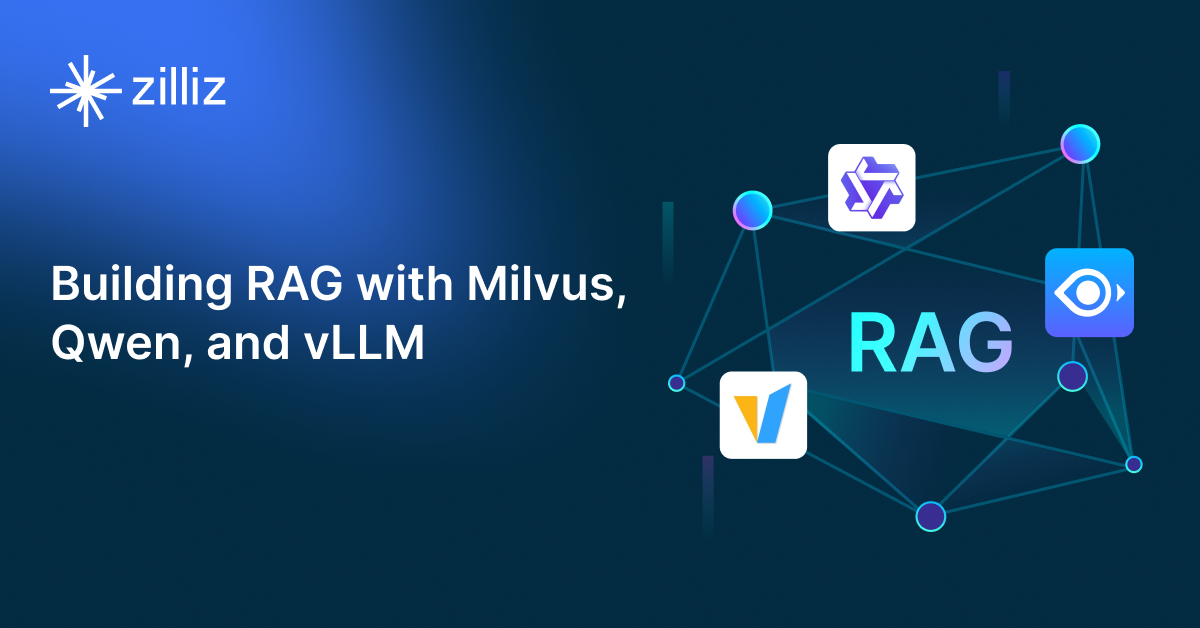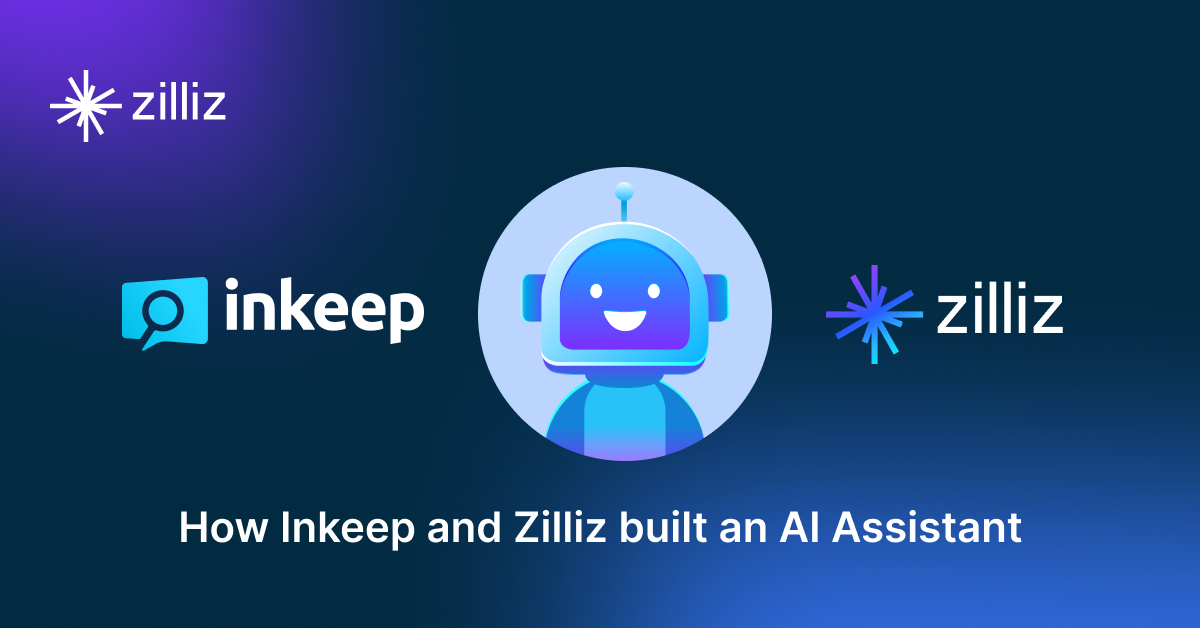Build RAG Chatbot with LangChain, Zilliz Cloud, Mistral AI Pixtral Large, and IBM granite-embedding-107m-multilingual
Introduction to RAG
Retrieval-Augmented Generation (RAG) is a game-changer for GenAI applications, especially in conversational AI. It combines the power of pre-trained large language models (LLMs) like OpenAI’s GPT with external knowledge sources stored in vector databases such as Milvus and Zilliz Cloud, allowing for more accurate, contextually relevant, and up-to-date response generation. A RAG pipeline usually consists of four basic components: a vector database, an embedding model, an LLM, and a framework.
Key Components We'll Use for This RAG Chatbot
This tutorial shows you how to build a simple RAG chatbot in Python using the following components:
- LangChain: An open-source framework that helps you orchestrate the interaction between LLMs, vector stores, embedding models, etc, making it easier to integrate a RAG pipeline.
- Zilliz Cloud: a fully managed vector database-as-a-service platform built on top of the open-source Milvus, designed to handle high-performance vector data processing at scale. It enables organizations to efficiently store, search, and analyze large volumes of unstructured data, such as text, images, or audio, by leveraging advanced vector search technology. It offers a free tier supporting up to 1 million vectors.
- Mistral AI Pixtral Large: This advanced model is engineered for high-quality image and text generation. With its robust architecture, it excels in tasks such as creative content generation, image enhancement, and multimedia integration. Ideal for applications in marketing, design, and entertainment, Pixtral Large delivers impressive results while maintaining a user-friendly experience.
- IBM granite-embedding-107m-multilingual: This AI model specializes in generating multilingual embeddings, allowing for semantic understanding across various languages. With 107 million parameters, it excels in tasks such as cross-lingual retrieval, translation, and sentiment analysis, making it ideal for global applications that require nuanced understanding of diverse linguistic contexts.
By the end of this tutorial, you’ll have a functional chatbot capable of answering questions based on a custom knowledge base.
Note: Since we may use proprietary models in our tutorials, make sure you have the required API key beforehand.
Step 1: Install and Set Up LangChain
%pip install --quiet --upgrade langchain-text-splitters langchain-community langgraph
Step 2: Install and Set Up Mistral AI Pixtral Large
pip install -qU "langchain[mistralai]"
import getpass
import os
if not os.environ.get("MISTRAL_API_KEY"):
os.environ["MISTRAL_API_KEY"] = getpass.getpass("Enter API key for Mistral AI: ")
from langchain.chat_models import init_chat_model
llm = init_chat_model("pixtral-large-latest", model_provider="mistralai")
Step 3: Install and Set Up IBM granite-embedding-107m-multilingual
pip install -qU langchain-ibm
import getpass
import os
if not os.environ.get("WATSONX_APIKEY"):
os.environ["WATSONX_APIKEY"] = getpass.getpass("Enter API key for IBM watsonx: ")
from langchain_ibm import WatsonxEmbeddings
embeddings = WatsonxEmbeddings(
model_id="ibm/granite-embedding-107m-multilingual",
url="https://us-south.ml.cloud.ibm.com",
project_id="<WATSONX PROJECT_ID>",
)
Step 4: Install and Set Up Zilliz Cloud
pip install -qU langchain-milvus
from langchain_milvus import Zilliz
vector_store = Zilliz(
embedding_function=embeddings,
connection_args={
"uri": ZILLIZ_CLOUD_URI,
"token": ZILLIZ_CLOUD_TOKEN,
},
)
Step 5: Build a RAG Chatbot
Now that you’ve set up all components, let’s start to build a simple chatbot. We’ll use the Milvus introduction doc as a private knowledge base. You can replace it with your own dataset to customize your RAG chatbot.
import bs4
from langchain import hub
from langchain_community.document_loaders import WebBaseLoader
from langchain_core.documents import Document
from langchain_text_splitters import RecursiveCharacterTextSplitter
from langgraph.graph import START, StateGraph
from typing_extensions import List, TypedDict
# Load and chunk contents of the blog
loader = WebBaseLoader(
web_paths=("https://milvus.io/docs/overview.md",),
bs_kwargs=dict(
parse_only=bs4.SoupStrainer(
class_=("doc-style doc-post-content")
)
),
)
docs = loader.load()
text_splitter = RecursiveCharacterTextSplitter(chunk_size=1000, chunk_overlap=200)
all_splits = text_splitter.split_documents(docs)
# Index chunks
_ = vector_store.add_documents(documents=all_splits)
# Define prompt for question-answering
prompt = hub.pull("rlm/rag-prompt")
# Define state for application
class State(TypedDict):
question: str
context: List[Document]
answer: str
# Define application steps
def retrieve(state: State):
retrieved_docs = vector_store.similarity_search(state["question"])
return {"context": retrieved_docs}
def generate(state: State):
docs_content = "\n\n".join(doc.page_content for doc in state["context"])
messages = prompt.invoke({"question": state["question"], "context": docs_content})
response = llm.invoke(messages)
return {"answer": response.content}
# Compile application and test
graph_builder = StateGraph(State).add_sequence([retrieve, generate])
graph_builder.add_edge(START, "retrieve")
graph = graph_builder.compile()
Test the Chatbot
Yeah! You've built your own chatbot. Let's ask the chatbot a question.
response = graph.invoke({"question": "What data types does Milvus support?"})
print(response["answer"])
Example Output
Milvus supports various data types including sparse vectors, binary vectors, JSON, and arrays. Additionally, it handles common numerical and character types, making it versatile for different data modeling needs. This allows users to manage unstructured or multi-modal data efficiently.
Optimization Tips
As you build your RAG system, optimization is key to ensuring peak performance and efficiency. While setting up the components is an essential first step, fine-tuning each one will help you create a solution that works even better and scales seamlessly. In this section, we’ll share some practical tips for optimizing all these components, giving you the edge to build smarter, faster, and more responsive RAG applications.
LangChain optimization tips
To optimize LangChain, focus on minimizing redundant operations in your workflow by structuring your chains and agents efficiently. Use caching to avoid repeated computations, speeding up your system, and experiment with modular design to ensure that components like models or databases can be easily swapped out. This will provide both flexibility and efficiency, allowing you to quickly scale your system without unnecessary delays or complications.
Zilliz Cloud optimization tips
Optimizing Zilliz Cloud for a RAG system involves efficient index selection, query tuning, and resource management. Use Hierarchical Navigable Small World (HNSW) indexing for high-speed, approximate nearest neighbor search while balancing recall and efficiency. Fine-tune ef_construction and M parameters based on your dataset size and query workload to optimize search accuracy and latency. Enable dynamic scaling to handle fluctuating workloads efficiently, ensuring smooth performance under varying query loads. Implement data partitioning to improve retrieval speed by grouping related data, reducing unnecessary comparisons. Regularly update and optimize embeddings to keep results relevant, particularly when dealing with evolving datasets. Use hybrid search techniques, such as combining vector and keyword search, to improve response quality. Monitor system metrics in Zilliz Cloud’s dashboard and adjust configurations accordingly to maintain low-latency, high-throughput performance.
Mistral AI Pixtral Large optimization tips
Pixtral Large is a high-performance multimodal model optimized for advanced reasoning across text and image inputs. Optimize retrieval by ensuring efficient document and image indexing, leveraging hybrid search to find the most relevant multimodal content. Use structured context formatting to provide clear relationships between retrieved text and images, preventing ambiguity in model responses. Adjust inference settings by dynamically controlling retrieval depth—fetching broader context for complex multimodal queries and focusing on narrower, high-precision retrieval for simpler ones. Optimize token efficiency by filtering out redundant data before passing it to the model, ensuring inference speed remains high. Use caching for frequently requested multimodal queries to reduce processing overhead. If deploying Pixtral Large in production, distribute inference across multiple nodes to handle large-scale workloads effectively while maintaining latency targets.
IBM granite-embedding-107m-multilingual optimization tips
To optimize the IBM granite-embedding-107m-multilingual model in a Retrieval-Augmented Generation (RAG) setup, start by fine-tuning the model on domain-specific data to improve its relevance and contextual understanding. Use batch processing for embedding generation to enhance throughput, and implement caching mechanisms for frequently queried embeddings to reduce latency. Regularly evaluate and update your retrieval strategies using various metrics, such as precision and recall, to ensure you're consistently retrieving the most pertinent data. Additionally, consider augmenting your dataset with diverse multilingual inputs to develop a more robust understanding of different languages, and experiment with different hyperparameter settings, such as learning rates and embedding dimensions, to find the optimal configuration for your specific use case.
By implementing these tips across your components, you'll be able to enhance the performance and functionality of your RAG system, ensuring it’s optimized for both speed and accuracy. Keep testing, iterating, and refining your setup to stay ahead in the ever-evolving world of AI development.
RAG Cost Calculator: A Free Tool to Calculate Your Cost in Seconds
Estimating the cost of a Retrieval-Augmented Generation (RAG) pipeline involves analyzing expenses across vector storage, compute resources, and API usage. Key cost drivers include vector database queries, embedding generation, and LLM inference.
RAG Cost Calculator is a free tool that quickly estimates the cost of building a RAG pipeline, including chunking, embedding, vector storage/search, and LLM generation. It also helps you identify cost-saving opportunities and achieve up to 10x cost reduction on vector databases with the serverless option.
 Calculate your RAG cost
Calculate your RAG cost
What Have You Learned?
By diving into this tutorial, you’ve unlocked the power of combining cutting-edge tools to build a RAG system from the ground up! You learned how LangChain acts as the glue, seamlessly orchestrating workflows between components like Zilliz Cloud (your high-performance vector database) and Mistral AI’s Pixtral Large (the LLM that generates human-like responses). The IBM granite-embedding-107m-multilingual model stepped in to convert text into rich, language-agnostic embeddings, ensuring your system understands queries in multiple languages and retrieves the most relevant context from Zilliz’s vector storage. Together, these pieces form a dynamic pipeline where LangChain manages the flow—fetching data, querying the database, and feeding context to Mistral’s LLM for precise, informed answers. Plus, you picked up pro tips like optimizing chunk sizes for faster searches and balancing cost-efficiency with accuracy, all while using the free RAG cost calculator to estimate expenses upfront. How cool is that?
Now you’re equipped to build smarter, multilingual applications that retrieve and reason with data! Whether you’re enhancing customer support bots or creating personalized content tools, you’ve seen firsthand how flexible these technologies are. The tutorial didn’t just hand you code—it gave you a blueprint to experiment, tweak, and innovate. Imagine scaling this system with real-time data, adding custom filters in Zilliz, or fine-tuning Mistral’s outputs for your niche. The possibilities are endless, and you’ve got the skills to explore them. So fire up your IDE, play with those embeddings, and let your creativity run wild. The future of intelligent apps is yours to shape—build something amazing, optimize fearlessly, and keep pushing the boundaries of what RAG can do. Let’s go! 🚀
Further Resources
🌟 In addition to this RAG tutorial, unleash your full potential with these incredible resources to level up your RAG skills.
- How to Build a Multimodal RAG | Documentation
- How to Enhance the Performance of Your RAG Pipeline
- Graph RAG with Milvus | Documentation
- How to Evaluate RAG Applications - Zilliz Learn
- Generative AI Resource Hub | Zilliz
We'd Love to Hear What You Think!
We’d love to hear your thoughts! 🌟 Leave your questions or comments below or join our vibrant Milvus Discord community to share your experiences, ask questions, or connect with thousands of AI enthusiasts. Your journey matters to us!
If you like this tutorial, show your support by giving our Milvus GitHub repo a star ⭐—it means the world to us and inspires us to keep creating! 💖
- Introduction to RAG
- Key Components We'll Use for This RAG Chatbot
- Step 1: Install and Set Up LangChain
- Step 2: Install and Set Up Mistral AI Pixtral Large
- Step 3: Install and Set Up IBM granite-embedding-107m-multilingual
- Step 4: Install and Set Up Zilliz Cloud
- Step 5: Build a RAG Chatbot
- Optimization Tips
- RAG Cost Calculator: A Free Tool to Calculate Your Cost in Seconds
- What Have You Learned?
- Further Resources
- We'd Love to Hear What You Think!
Content
Vector Database at Scale
Zilliz Cloud is a fully-managed vector database built for scale, perfect for your RAG apps.
Try Zilliz Cloud for Free


